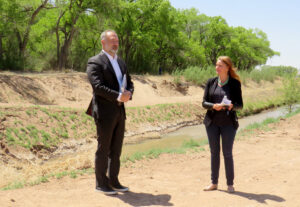Forensic team releases preliminary assessment of 2020 mid-Michigan dam failures

A five-person forensic team appointed by the Federal Energy Regulatory Committee has determined at least one of the culprits of the mid-Michigan dam failures that caused an estimated $200 million in property damage in May 2020.
The five-person Independent Forensic Team (IFT) released its interim report Monday, but noted a more detailed analysis will not be completed for another several months. The interim report focuses on the geological, structural and weather factors that caused the dam failures. The upcoming report will cover the human factors the IFT determines contributed to the disaster.
For the time being, the IFT is laying the blame for the failure of the Edenville Dam and subsequent topping of the Sanford Dam on a process identified as static liquefaction, which the report calls the “most plausible principle mechanism” for the Edenville Dam breach.
As a failure mechanism, stated the IFT, static liquefaction is “rare, but not unprecedented.”
The report explains: “Static liquefaction is a phenomenon in which a saturated, loose sand tends to lose strength and collapse rapidly under sustained (static) shear loading, generating high pore water pressure in the soil mass and very low strength. The stress-strain behavior is brittle, and the low residual strength is much lower than the static shear stresses, creating a large force imbalance, acceleration and velocity, and flow of the soil mass.”
Static liquefaction, the IFT concludes, caused the collapse of the Edenville Dam embankment. The downstream embankment failed in 10 seconds, creating an opening between 40 feet and 80 feet. The upstream embankment remained intact for another 10 seconds to 20 seconds before it, too, washed away. Water released from the total breach of the dam cascaded downstream to top the Sanford Dam and flood wide swathes of Midland County, including much of the downtown area.
The IFT relied heavily on home video of the failure of the Edenville Dam. Based on IFT analysis, the heavy rains pounding mid-Michigan during the preceding days dropped up to 6 inches of precipitation, which “almost certainly contributed to the static liquefaction instability failure.” Wixom Lake, actually an impoundment created by the Edenville Dam, was 5.5 feet above normal levels.
Although the water level was at a record high, the report concludes the failure of the Edenville Dam was not caused by water overtopping the dam. Relying on the home video, the IFT said the visual evidence is not consistent with the overtopping hypothesis.
The IFT also determined internal erosion was not to blame for the Edenville Dam failure. “With no signs of significant seepage or eroding material from the dam face, the available information does not support the sudden breach being principally caused by internal erosion. … Regardless of whether the embankment was bi-zoned or homogeneous, the conclusion would be the same: the lack of observed seepage or embankment distress prior to the sudden failure does not support internal erosion as the primary failure mechanism.”
This article was originally posted on Forensic team releases preliminary assessment of 2020 mid-Michigan dam failures







